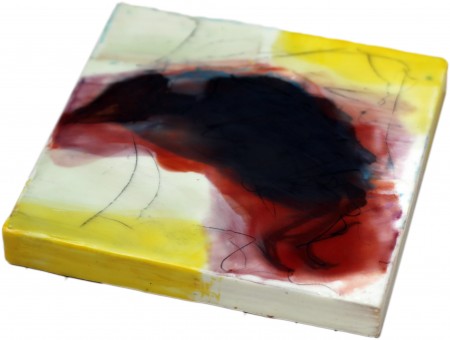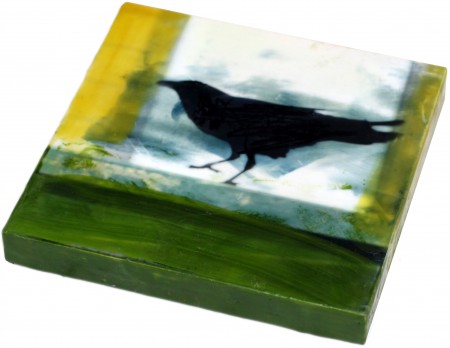cleaning the studio...
...and other adventures in artThe Daily Bird, Days 21 and 22
painting is a jealous mistress

I’m going to be cantankerous and withhold The Daily Bird today so that I can write about painting instead. And don’t think I don’t have the Daily Bird done. Here’s a thumbnail, with a larger image coming tomorrow.
I’m spending all my time right now doing encaustic because I have an ever-nearing deadline for these 50 pieces, but I’m thinking about painting.
The in-progress paintings destined for my show in November are propped against the wall in my studio. Not in the drying racks, but against the wall where I will see them every time I walk in. They are begging for attention.
Painting is a jealous mistress. I can spend my time doing other things, as long as it’s somehow about painting. You painters in the audience will know what I’m talking about. Painting can be all-encompassing. Everything I do in my art practice has some bearing on my painting.
And perhaps that’s why I don’t paint all the time. It can be claustrophobic and can easily become too self-referential, so I find myself needing to step away for a bit.
These 50-pieces-in-50-days encaustic pieces are, by their very nature, sketch-like. I quickly found that I can’t do one piece a day using my usual encaustic methodology. So these pieces became about other things. Composition and color. Line and gesture. Capturing some essence of ‘birdness’. Representing the ambiguous nature of a single moment in time.
In many ways, they become more like my paintings.
On the left is a Daily Bird, 6″x6″ encaustic. On the right After the Fall, oil on canvas, 60″x36″. The color palettes, medium, and subject matter are different, but they both share a similar use of space, with the bird or the figure trapped within the geometry imposed on the picture plane. Both have a sort of containment of the subject matter.
On the left, another Daily Bird, 6″x6″ encaustic. On the right, Repose II, oil on canvas, 28″x26″. In both of these, I was looking at a sort of off-kilter balance to the piece, and the use of gestural line in the two pieces is similar.
Saved for another day is a discussion of why my color palette is different in encaustic versus oil painting, and why I do figurative oil paintings but rarely do figurative encaustic. Don’t hold your breath, though…I have 28 more birds to do first.
The Daily Bird, Day 20

Day twenty of the Sanchez Art Center 50-50 show, 50 pieces in 50 days. Encaustic/Oil/Photo on Panel, 6″ x 6″
The Daily Bird, Day 19

Day nineteen of the Sanchez Art Center 50-50 show, 50 pieces in 50 days. Encaustic/Oil/Photo on Panel, 6″ x 6″
The Daily Bird, Day 18
In all my work (paintings, sculpture, encaustic) I am drawn to the idea of obscuring part or even all of the image. I have varying degrees of success on this front, but the idea is always there with me. To my mind, it works well in this one.

Day eighteen of the Sanchez Art Center 50-50 show, 50 pieces in 50 days. Encaustic/Oil/Photo on Panel, 6″ x 6″
The Daily Bird, Day 17

Day seventeen of the Sanchez Art Center 50-50 show, 50 pieces in 50 days. Encaustic/Oil/Photo on Panel, 6″ x 6″
The Daily Bird, Day 16

Day sixteen of the Sanchez Art Center 50-50 show, 50 pieces in 50 days. Encaustic/Oil/Photo on Panel, 6″ x 6″
what the heck is encaustic, anyway?!?
People ask, so here it is: a short explanation of encaustic…
- As with any work of fine art, handle encaustic paintings with care: keep out of direct sunlight, avoid extreme temperatures, and keep away from heat sources.
- When transporting, wrap in waxed paper, photo release paper or glassine.
- If desired, the surface can occasionally be gently buffed to a lustrous finish using a soft, clean, cotton cloth. Bloom—a whitish haze—can occur on the surface of the wax and is removed with gentle buffing using a soft cloth.
- Bloom is a normal chemical reaction within the wax, and will cease over time as the wax cures.
- Protect the surface and edges to prevent chipping and scratching.
- Framing behind glass is not recommended due to potential heat build-up. If you would like to frame your piece, a simple floating frame that protects the edges and extends slightly above the surface of the painting is preferable.
There is so much variety in what artists do with encaustic that I can’t begin to represent it here. There are many books out there showcasing encaustic artists and various techniques, including a beautiful new book by fellow Santa Cruz artist Daniella Woolf, Encaustic with a Textile Sensibility. In the studio, I often find myself referring to the classic, The Art of Encaustic Painting, by Joanne Mattera.
I learned encaustic by taking an intensive workshop put on by R&F Paints, manufacturer of encaustic supplies and the incredible oil paint sticks that I use in both my painting and encaustic practices. Their website is a wealth of information if you are interested in learning more about encaustic.
The Daily Bird, Day 15

Day fifteen of the Sanchez Art Center 50-50 show, 50 pieces in 50 days. Encaustic/Oil/Photo on Panel, 6″ x 6″
The Daily Bird, Day 14

Day fourteen of the Sanchez Art Center 50-50 show, 50 pieces in 50 days. Encaustic/Oil/Photo on Panel, 6″ x 6″






